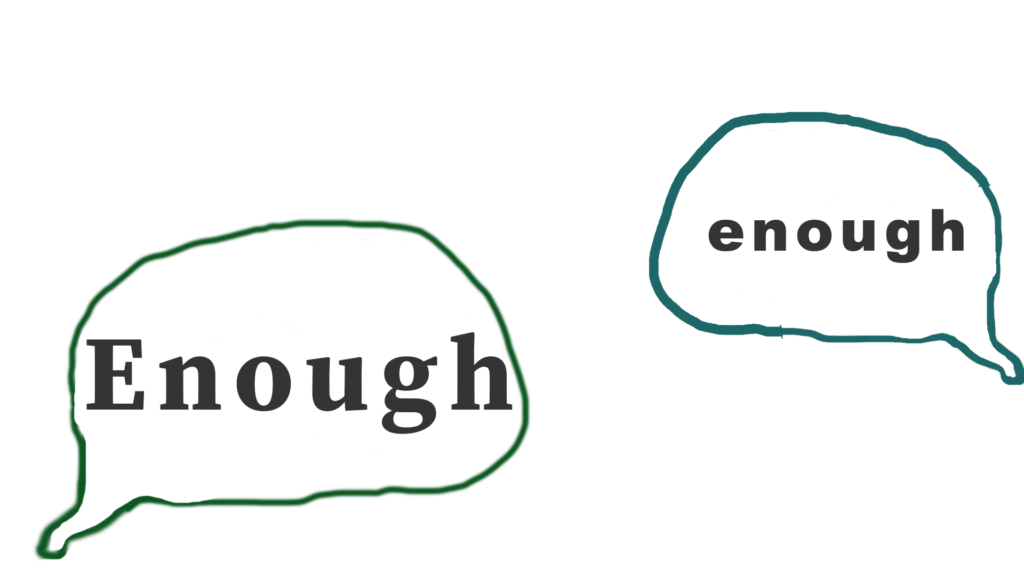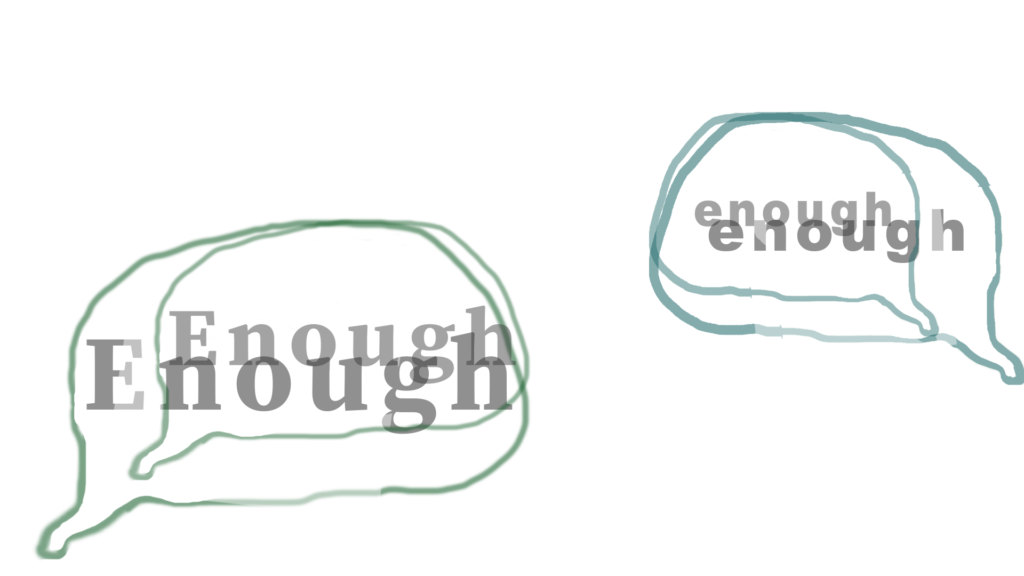When I think of the word enough, I hear the razor blade of my sister’s voice when the dogs keep barking. A command. An admonishment. Enough.
I feel the sliver of nervous anticipation before a new friend comes over and I take stock of the bowls of potato chips on the table and the six-pack of Heineken in the fridge. An accounting ledger. A social tissue. An expression of care. Is there enough?
I remember the taste of bile in my throat as the last day of production approached with 4 scenes left to shoot and a budget too small to keep going beyond that day (and I suppose before that: growing up with standardized tests and essay deadlines and exams closing in on me). A possession. A lack thereof. Not enough, never enough time.
What about enough change, enough progress, enough time? As climate crises continue, exacerbate, intersect in increasingly destructive ways, I ask myself, and climate work more generally: what is enough? Becoming vegetarian and driving EVs and recycling shampoo bottles cannot outpace the rates of extraction and burning of fossil fuels. Moreover, if we were to stop drilling altogether, it might reduce harm in the present moment, but would not be enough to stop destruction from happening. So what is enough?
I grapple with enough because the tensions within this single word are often easier to distill than the bigger questions that arise in the context of the climate crisis. In turn, these distillations offer a seedbed to engage those bigger questions without being overwhelmed by them.
The astonishment of language is that it can inhabit multiple meanings simultaneously, but the crisis of language is its ability to both inhabit and evade a singular definition. Enough can mean a limit being reached, or a fulfillment of sorts, or it can be placed alongside its negative to indicate lack. For me, this word has always produced some level of anxiety: a doubt around the type of productivity I’m dedicating to a day or an essay; or a self-help mantra reflected back on my social media feeds: you are enough. When I finally looked it up, I was surprised to learn that its definition has to do with being satisfied or satiable. It isn’t actually about restriction or limitation at all. The dog has barked to completion; the chips are sufficient.
To reflect on the origin of this anxiety, it’s helpful for me to articulate the origin of this essay, which started with a metaphor: words are seeds. Each word holds within it a future life and the capacity to imagine something new. If a word is a seed, then everything else becomes soil: the sentence it is placed within, the person who speaks it aloud, the socio-political and cultural landscape wherein they reside. The question ‘what is enough?’ looms for anyone thinking critically about what it means to live within the confining structures of a neoliberal capitalist society. I have heard friends pose this question to themselves in calculating the tradeoff between feeling depleted throughout a work day—throughout every work day for the next five to ten years—so that they can have financial stability for themselves and their family and their dreams later. I’ve been in conversations where this is posed as a hypothetical for the CEOs of Exxon (Darren Woods) or Amazon (Jeff Bezos) or Chase Bank (Jamie Dimon) as it becomes more confusing how someone could possibly justify a new oil rig or gross profit margins when it comes at the expense of our ability to breathe clean air. The answer always feels like a sigh, a disappointment: neoliberal capitalism does not seek to satisfy and is not satiable. It seeks to grow. It seeks to extract. It seeks to sustain itself, no matter the cost.
This scarcity mindset colors the mis/understanding of how we define this word, but more importantly, it obscures the fact that there is more than enough: there is plenty; there is abundance. Being able to construct new narratives requires new language, but it also requires owning the meanings of language we’ve inherited. Words in combination, rooting into each other, have the power to articulate a different future altogether. When we place words alongside each other in surprising patterns, we create new meaning. I suppose this is another way of describing metaphor: metaphor is our bridge to making language more material and owning the language we’ve inherited.
I wanted to learn how to animate this idea of language as a seed—metaphorically, but also literally. Visuals offer meaning when words fall too sharp and also too flat, when even metaphors feel like an exaggeration and an inadequacy. It’s a comfort to be able to turn away from language, even as I write and think about it. As I sit in front of Photoshop, trying to turn words into seeds, I click on an icon: a series of circles following one another. I haven’t yet learned the software and so am still moving on instinct and curiosity, and so this is how I learn about tweening. Short for in-betweening, it’s a way of speeding up the notoriously slow animation process by taking two frames and overlaying them. The combination of frames makes motion more fluid, more like motion.



I expand the speech bubble, forcing it to stretch into a shape that looks more like a speech bubble and then shrink it unnaturally to mold it into the shape of a seed. In this process, I start thinking about linguistic tweening. There’s a yearning for new words. Can we use it to build or visualize definitions that feel more true to a word’s actual meaning? “Climate change” becomes “climate crisis” – to mobilize people, to express the urgency of now. Global South becomes Global Majority – to create inclusion where it did not exist before. These progressions in language are significant.
And also, I have put the letters e and n and o and u and g and h alongside each other so often in the process of writing this essay that the word itself loses its meaning sometimes. Language itself becomes meaningless often, whether in the face of repetition or in moments where words are inadequate. Your house can become engulfed in flames that engulf the only lands you’ve ever called home; your neighbor could die because she cannot afford air conditioning. Language cannot touch the materiality of a wall of fire crashing into your windows or the body’s instinct is to sleep when it is too hot to do anything else. In this light, the language feels like a data point at best, or, at worst, a weapon and violence. The unbearably big questions resurface: Who gets to live? Who gets to live their lives? Who gets to live their lives on their tongues?
Meaning-making happens through language and lived experience alike, but the tension between the two exposes an urge to identify one as more meaningful, in the same way that asking the question what is enough? exposes an impulse to answer it. The impulse towards definition reflects a bigger climate wish: if we answer what enough is, then maybe we have the information that will lead to decisions that can be part of a chain reaction of events that reverse global climate change. But even this kind of thinking misses the mark—widely, embarrassingly so. To answer this question requires a level of knowability we cannot have, an ability to project ourselves into a future where we’ll know exactly what we want and need from one moment to the next, and where it is possible to calibrate it exactly to the wants and needs around us. In other words, it requires the neoliberal capitalist logic that everything is finite and therefore we can make carefully laid out, rational decisions without any variability (except for competition).
In the process of writing and animating this piece, I find myself repeatedly trying to hone in on definitions, experiment with mediums that might better encompass what I’m trying to say, settle on something that will make the push and pull of these questions rest. But more honestly: thinking about language and climate is messy, my metaphors get bungled all the time, there is no such thing as enough and there is no such thing as not enough. Tweening has offered a way out of thinking only in terms of definitions by emphasizing the movement in-between. Applying tweening to movement building, it provides a framework to lay out steps between now and “the future”. What does now look like? What does an ideal future look like? And what are the 10 frames in between those two points in time? Whether you define those frames as “policies” or “steps” or generally “things that need to happen”, how can the incremental steps create motion and movement? By shifting our attention from the yearning for definition to the movement itself, we resist the impulse to control— ourselves and others.
But tweening also offers a reminder of how easy it is to see the 10th frame as the final one. Sometimes I pause my animation, play it, and replay it. Sometimes I do this with an eye toward improving it—how do I make the speech bubble expand as if someone is breathing into it?—but if I’m honest, I’m also excited by the movement, the translation of this idea to fruition, creating a moment of motion where there had been nothing before. And given how much time I spend with each frame—two hours yields a 14-second clip—I want to replay the full video to see each frame as part of the whole. As I do this, I’m reminded of how often, historically, we’ve rested on the sufficiency of forwarding momentum. Identify a step, take it (and sometimes we don’t get that far), and name it progress – all without making a big enough impact to actually create a just world, without acknowledging that what we envision for a just world requires respect for changing what that world looks like with new information. It’s a humbling experience to realize you’re stuck, whether in a frame or a political movement.
And this offers encouragement to grow beyond the places of being stuck. Thinking through a word does not offer the material support that mutual aid does; that being part of a community does; that an environmentally just policy does. But in thinking through the word enough, it’s possible for me to put a name to the ways I’m entangled in certain types of thinking—a neoliberal, capitalist, patriarchal, white supremacist—to identify ways I can keep untangling, keep extracting myself from the types of thinking that created a world I am so afraid of, so ashamed of, that has hurt so many people I love and has hurt so many more I don’t know. How can we use this to inform some of the ways we approach the imaginative work required to create solutions that step outside of linear paths? How do we let movement inform how we can move differently? Some of the analogues between the animation process and climate work feel hopeful to me: in slowing down, we speed up; by hovering in the tweening, the motion, rather than the definition of a single frame, we can tween towards the futures we want.
About the Author
Michelle Cheripka (she/her) is an interdisciplinary media maker focusing on personal experiences of systemic issues. She is currently based in Los Angeles.

